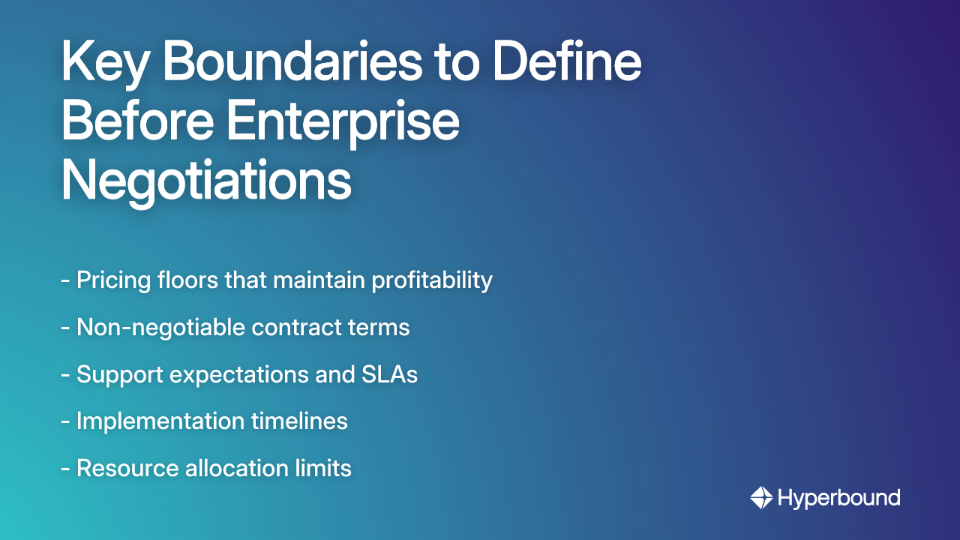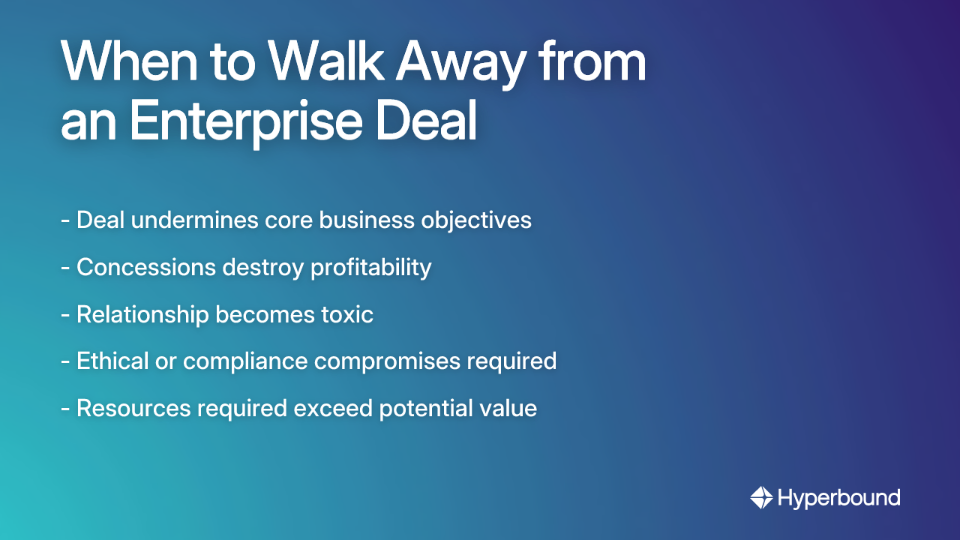
You've experienced it before. The endless meetings. The shifting requirements. The power plays. The feeling that your enterprise client is running you in circles while holding a seven-figure deal over your head. Sometimes they know exactly how much leverage their spending power gives them.
Enterprise sales is defined by one word: Complexity.
Behind that complexity lies an uncomfortable truth that many sales leaders won't openly discuss—the power dynamic is fundamentally unbalanced. Your enterprise customers hold most of the cards, and they know it.
But here's the thing: you're not powerless. While the substantial spending power of enterprise customers gives them significant leverage, you can navigate these complex relationships, protect your business value, and build mutually beneficial partnerships—if you understand the game being played and master the right strategies.
This guide will break down why this power imbalance exists, provide a toolkit of actionable strategies to manage it, and clarify when your most powerful move might be walking away.
The Unbalanced Scale: Understanding the Enterprise Power Dynamic
The Power of the Purse
At the core of the enterprise power dynamic is simple economics. Enterprise contracts represent substantial revenue—often making up significant portions of a vendor's business. This purchasing power allows enterprise clients to dictate terms in ways smaller clients simply cannot.
As one sales veteran put it bluntly on Reddit, "The customers can be hit or miss; they know they have power because of their spend."
This leverage often manifests in controlling behaviors:
- Demanding significantly lower prices
- Requesting custom features without corresponding budget increases
- Expecting priority support without premium service agreements
- Stretching payment terms to 60, 90, or even 120 days
- Requiring complex compliance and security measures on short notice
Each of these creates friction between perceived value and cost, often resulting in vendors making painful concessions to secure or maintain the relationship.
The Danger of Dependency: Nowhere Else to "Mine for Gold"
Over-reliance on a few key enterprise clients creates another vulnerability that savvy buyers exploit. When a single customer represents 20%, 30%, or even 50% of your revenue, their departure could be catastrophic.
As one sales professional candidly observed, "If the relationship deteriorates and you start losing deals there is nowhere else for you to go mine for gold."
This reality creates a dangerous dependency where you may accept increasingly unfavorable terms simply to preserve the relationship. Research from Harvard Business Review confirms this is a substantial business risk that can threaten financial stability if that customer switches suppliers or faces their own adversity.
The High-Stakes Environment
In enterprise sales, there's immense pressure and scrutiny on every deal. As one practitioner notes, "There is much more internal visibility and oversight on your deals."
The stakes are dramatically higher: "if a deal fall out, it really hurts you." This creates an environment where every detail matters "to the 10x degree" and where a single misstep can derail months of work.
This combination of customer power, vendor dependency, and high-stakes deals creates the perfect conditions for challenging client behaviors. But understanding this dynamic is the first step toward navigating it effectively.
Playing Your Hand: A Strategic Toolkit for Rebalancing the Relationship
Success in enterprise sales requires a different approach. You can't come across as a "salesman" at any stage. Instead, you need a "full strategic approach" where you execute against a plan. Here's that plan:
The Foundation: Preparation and Mindset
Do Your Homework
Before any negotiation, conduct deep research into your customer's business needs, market position, and key stakeholders. This isn't just about your product; it's about their world.
Enterprise buying decisions aren't made in a vacuum—they're influenced by:
- Industry trends and competitive pressures
- Regulatory requirements
- Internal politics and power dynamics
- The economic buyer's personal incentives and success metrics
- Previous experiences with vendors in your category
By understanding these factors, you can position your offering as a strategic solution rather than just another product or service.
Define Your Bottom Line
Before you even talk to the client, you must "know your minimum acceptable terms." Clarify the least favorable deal you can accept while maintaining profitability and business integrity. This prevents you from making costly concessions in the heat of the moment.
Document your non-negotiables around:
- Pricing floors
- Contract terms
- Support expectations
- Implementation timelines
- Resource allocation
Having these boundaries clearly defined internally gives you the confidence to hold firm when necessary and prevents emotional decision-making during tense negotiations.

The Engagement: Building Genuine Leverage
Build Champions, Not Just Contacts
You have to move beyond a single point of contact (SPOC). The goal is to multi-thread by building cross-functional relationships. To succeed in enterprise sales, you need to "build champions" inside the organization who will advocate for you and help drive consensus.
This is crucial because, as one sales professional observes, the SLT (Senior Leadership Team) often "do not want to go out on a limb without field support."
Effective champion-building means:
- Identifying potential allies across different departments
- Understanding their personal and professional goals
- Equipping them with the tools and messaging to advocate on your behalf
- Providing them with visibility and recognition when they help advance the deal
Speak with Data-Driven Authority
Demonstrate confidence and expertise, but avoid aggression. Back your recommendations with hard data, statistics, and concrete examples. This builds credibility and trust, especially with clients resistant to change.
Pro Tip: Use AI to your advantage. Leverage platforms like Hyperbound to analyze thousands of your team's sales calls and uncover what your top reps do differently. By using features like AI Real Call Scoring, you can get objective, data-driven feedback on customer interactions to identify winning behaviors. This allows you to prepare for meetings with proven insights, not just pitches.
Build Real Rapport
Establish genuine connections to ease negotiations and foster goodwill. Don't let emotions dictate your responses; remain focused on the issues, not personalities. This means:
- Finding authentic common ground beyond just business interests
- Acknowledging and respecting the client's expertise in their domain
- Being transparent about challenges and limitations
- Demonstrating consistency in your communication and follow-through

The Rules of the Game: Setting Professional Boundaries
Codify Boundaries in Your Agreements
Don't leave boundaries to chance. Modify your service agreements to include clauses on:
- The maximum number of revisions allowed
- Clear deadlines for feedback
- Scope change processes with associated costs
- Escalation procedures for disputes
This proactively addresses potential scope creep and repeated conflicts.
Control the Calendar
Restrict client calls to a structured schedule (e.g., once a week) to boost your team's productivity and protect their mental health. Promote asynchronous communication for non-urgent matters. Research from MIT Sloan Review shows that fewer meetings significantly boost productivity.
While T&E (Travel and Entertainment) expenses are part of enterprise sales, be judicious about in-person meetings. Each should have clear objectives and outcomes.
Master the Onboarding Process
Use detailed onboarding forms to clarify client needs, expectations, and project scope from the very beginning. Assign a dedicated project manager to serve as the operational lead, allowing the sales team to focus on relationship development and expansion opportunities.
The Ultimate Leverage: Knowing When to Walk Away
Your ultimate power comes from your willingness to walk away from a bad deal. This preserves your leverage and protects your business from toxic or unprofitable relationships.

Clear Triggers for Walking Away
Be prepared to exit when:
- The negotiations fundamentally undermine your core business objectives or values
- The client demands concessions so large that they destroy the deal's profitability
- The relationship becomes unmanageable or toxic, and all attempts to set boundaries have failed
- You're being asked to compromise on legal, ethical, or compliance requirements
How to Cut Ties Professionally
If you must end the relationship, do it right:
- Keep the Conversation Commercial: Focus on the business reasons, not personal feelings or complaints
- Be Professional and Clear: Handle the termination gracefully to protect your professional reputation
- Document Everything: Ensure you have a clear record of the decision and the communication surrounding it
From Power Struggle to Partnership
Enterprise sales is defined by complex power dynamics where customers often hold most of the cards. The substantial spending power of enterprise clients, combined with the risk of vendor dependency, creates an environment where difficult behaviors can flourish.
However, you're not powerless. By understanding these dynamics, preparing strategically, engaging with data-driven authority, setting firm boundaries, and maintaining your willingness to walk away, you can transform a lopsided power dynamic into a respectful partnership.
Enterprise sales is a long sales cycle that is both challenging and rewarding. With the right strategies, you can play your cards right and build a sustainable and profitable book of business—even when your customers hold most of the cards.
Remember: the goal isn't to "win" against the customer, but to create conditions where both parties win through a balanced, professional relationship that delivers genuine business value to all involved.

Frequently Asked Questions
What is the biggest challenge in enterprise sales?
The biggest challenge is the inherent power imbalance between the vendor and the enterprise customer. Enterprise clients often have significant leverage due to their large purchasing power, which can lead to demanding behavior, unfavorable terms, and high-pressure negotiations. The complexity of these deals requires a strategic approach to manage the relationship effectively.
Why do enterprise customers have so much power in negotiations?
Enterprise customers derive their power primarily from their substantial spending, often referred to as "the power of the purse." A single enterprise contract can represent a significant portion of a vendor's revenue. This creates a dependency where the vendor may be afraid to lose the deal, giving the customer leverage to dictate prices, request custom features, and control payment terms.
How can a salesperson build leverage with a powerful enterprise client?
You can build leverage by moving beyond a single point of contact and building a network of champions across different departments within the client's organization. This strategy, known as multi-threading, ensures you have internal advocates who understand your value and can help build consensus. Additionally, presenting your case with data-driven authority and establishing genuine rapport helps shift the dynamic from a simple transaction to a strategic partnership.
What are the most important boundaries to define before an enterprise negotiation?
Before entering any negotiation, you must define your "bottom line" or non-negotiables. Key boundaries to establish include minimum pricing floors to ensure profitability, non-negotiable contract terms (like liability and IP), clear support expectations and service level agreements (SLAs), and realistic implementation timelines. Having these defined prevents you from making poor decisions under pressure.
How do I professionally set boundaries with a demanding client?
Setting boundaries professionally involves being proactive and clear. Codify rules for scope changes, feedback deadlines, and revisions directly into your service agreements. Control the calendar by structuring meetings and encouraging asynchronous communication for non-urgent matters. This protects your team's time and prevents scope creep without damaging the relationship.
When is it the right time to walk away from an enterprise deal?
Walking away is your ultimate leverage and should be considered when a deal becomes fundamentally unprofitable or toxic. Key triggers include the client demanding concessions that destroy profitability, the relationship draining excessive resources, or requests that compromise your legal or ethical standards. Leaving a bad deal protects your business's long-term health and integrity.
Book a demo with Hyperbound
.png)













